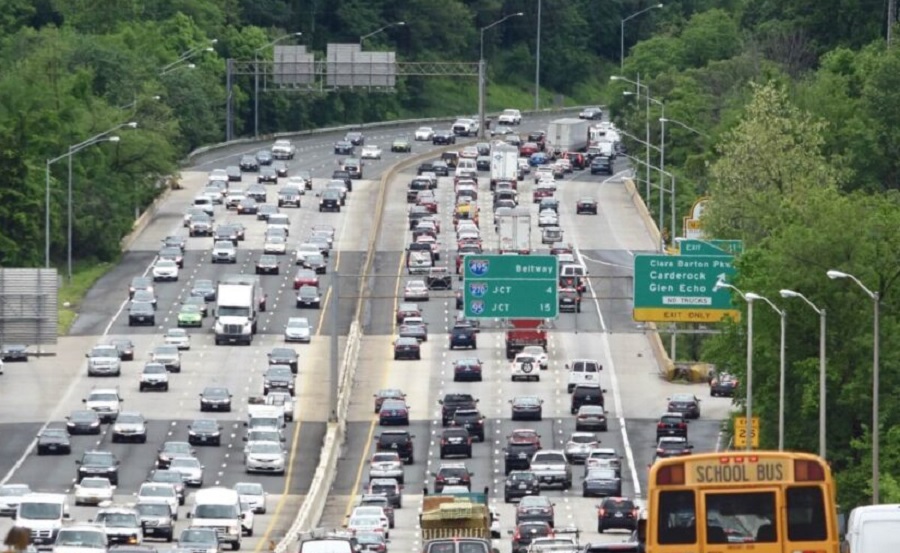
Traffic on the Capital Beltway near the American Legion Bridge. (Photo by Dave Dildine/WTOP News)
Maryland commuters don’t want to be exploited by toll-road profiteers, or held hostage and manipulated into paying high tolls on highways that fail to deliver on the promise of congestion relief.
Pouring rivers of concrete to create a magic carpet for rich people isn’t a solution to the mobility crisis in the fast-growing metropolitan Washington area. We can’t pave our way out of this mess by adding more lanes of traffic on the Beltway that will soon be just as crowded as they are now.
If Maryland gives in to Virginia’s pressure to extend the Interstate 495 Southside Express Lanes into Maryland, it will be outsourcing our state highway network to unaccountable privateers and their shareholders. With their hegemonic ambition to harvest tolls across the entire DMV and beyond, our citizens and their elected representatives will lose their ability to make transportation policy and protect the public interest.
This is just the latest chapter in the misbegotten scheme cooked up in 2017 to widen the Beltway and plunder Maryland’s commuters. If we’ve learned anything fighting this proposal for the past eight years, concession agreements to build, operate and manage toll lanes will be bound up in secret interstate accords, public-private partnership deals with foreign investors and contracts with expensive compensation clauses and penalties that kick in whenever a future transit project that’s outside the strict control of the toll regime threatens to actually improve commutes.
The solution to the region’s mobility crisis isn’t to make congestion and gridlock worse by adding new traffic backups and bottlenecks on local roads wherever the toll lanes begin and end.
The solution is a seamless, interconnected network of fast, safe and accessible rapid rail transit service, including expanded MARC service, completion of the Purple Line, and the Southern Maryland Rapid Transit (SMRT) project that’s being planned in the gridlocked Maryland Route 5-U.S. Route 301 corridor from the Branch Avenue Metrorail station to Waldorf and White Plains.
Until Maryland gets serious about the hard work of developing a long-term strategy for financing rapid rail transit, learning from the successes of other cities, regions and states across America, and the exceptional light rail and tram systems around the world, we will not be ready to seize the moment when our federal partners return in the post-Trump era.
When I was a young planner at the Metropolitan Washington Council of Governments in the early 1970s, and the construction of Metro was the biggest infrastructure project in America, we dreamed of a region where the automobile would not be the central organizing principle of our daily lives. A half-century later, instead of shifting our emphasis from highway investment to transit, we see this retrograde proposal to widen the Beltway as a retreat from the region’s vision of a sustainable future with mobility and economic opportunity for all.
– A summary of this statement was presented at the National Capital Region Transportation Planning Board meeting on July 16, 2025.
Editor’s note: This commentary originally appeared in Maryland Matters, which, like the Virginia Mercury, is part of States Newsroom.
NEWSLETTER SIGNUP
Subscribe to our newsletter! Get updates on all the latest news in Virginia.


![[Aggregator] Downloaded image for imported item #50020](https://allvirginia.news/wp-content/uploads/2025/08/Beltway_I-495_Dildine_2-1-1024x676-1-696x428.jpg)
